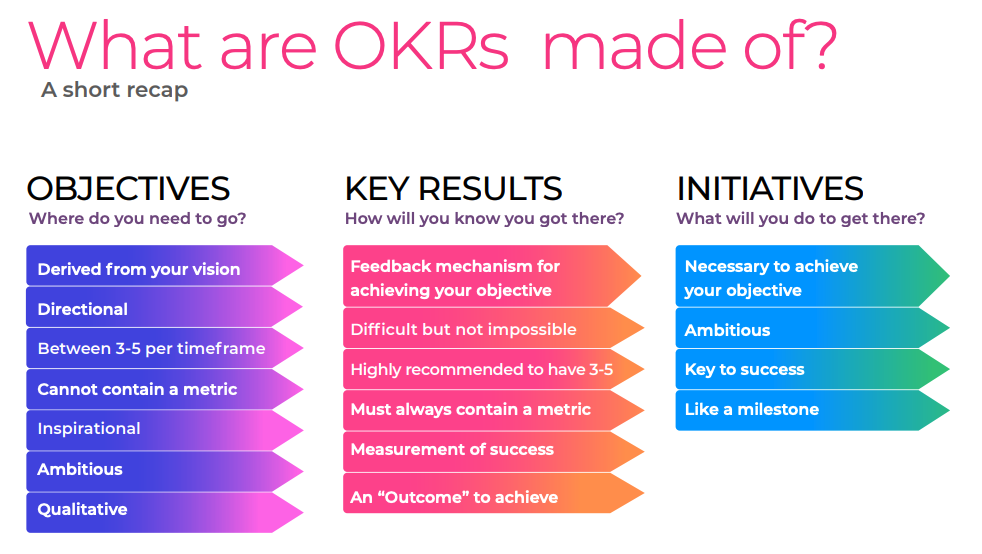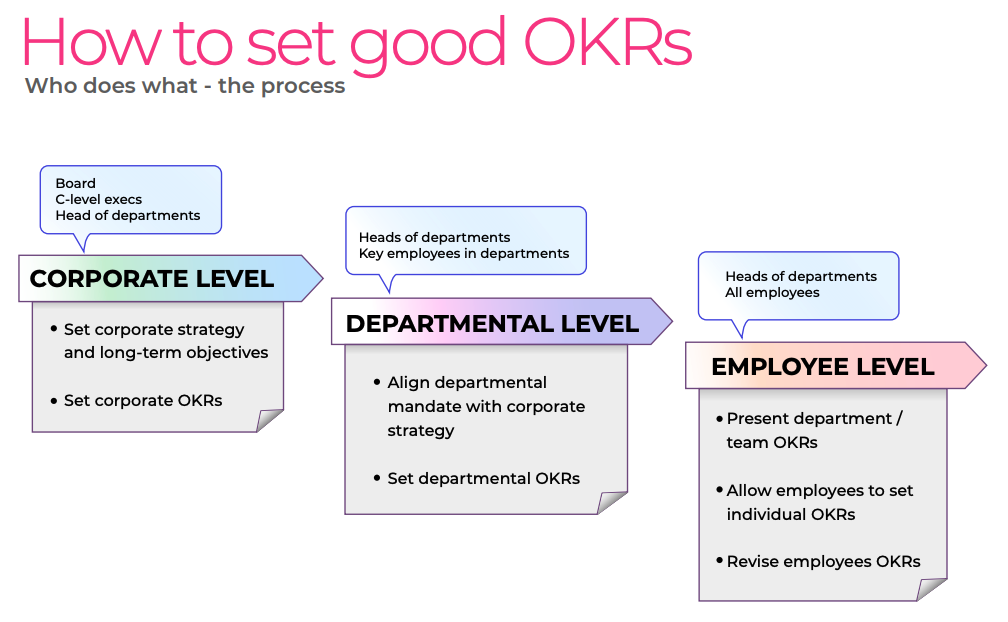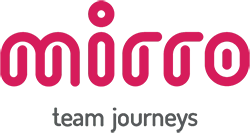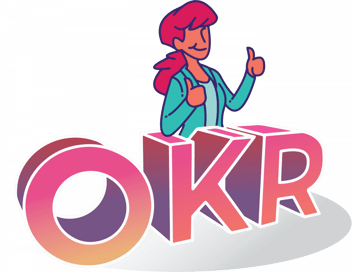SECTION
How to Write OKRs: A Guide for People Leaders


Listen to this article:
Note: This article was updated on February 9, 2024, adding new content covering the history of OKRs, details for ensuring complete alignment, a comprehensive step-by-step guide to writing effective OKRs, examples, and tips for overcoming common challenges.
Objectives and Key Results (OKRs) are a robust framework high-performing organizations use to set, measure, and achieve business goals. Effective goal-setting provides a clear roadmap for success and can significantly enhance company productivity and teamwork.
This framework ensures that teams prioritize their efforts, measure progress toward strategic outcomes, and promote a more cohesive and purpose-driven approach. OKRs create clarity, encourage collaboration, and empower people to take ownership of their goals and outcomes.
In this article, we will go through all the steps on how to write impactful OKRs that align with business objectives. Happy reading!
How to write an OKR: understanding the framework
In today's fast-paced and dynamic work environment, organizations constantly seek effective methods to drive success and achieve their goals. One popular method that has gained traction recently is the OKR framework.
By understanding the components of OKRs and their role in establishing a clear connection between results and objectives, teams can leverage this framework to drive performance and achieve organizational excellence.
The history of OKR
The modern OKRs as we know them today originated in Peter Drucker's groundbreaking book about management ("The Practice of Management"). Drucker emphasized the distinct role of management and identified a common challenge: the "activity trap," which hindered managers from focusing on broader company vision and long-term strategy. To address this issue, he introduced MBO (Management by Objectives).
Another critical historical moment for the evolution of the OKR framework took place in the '70s, when Andy Groove, then CEO at Intel, expanded upon Drucker's concept by introducing key results. From there, the OKR concept arose, giving Groove the title of the OKR pioneer.
John Doerr is also recognized as one the main figures behind this goal-setting framework, and his book ("Measure What Matters") can certainly be held responsible for all the companies deciding to experiment with OKRs themselves.
Google's rise to global prominence popularized OKRs, with the company's initiative re:Work further propelling its adoption. Numerous companies, including Airbnb, LinkedIn, Dropbox, Spotify, Netflix, Amazon, Facebook, Gap, Lear, Deloitte, and Adobe, embraced the OKR framework, customizing it to their needs.
OKR components
OKRs, short for Objectives and Key Results, provide organizations with a robust framework for setting and achieving goals. Objectives are broad, qualitative goals defining an organization or team's goals.

OBJECTIVES are:
- Significant — this aspect separates an objective from a task and will show you where you want to go. If you aim to cross the street merely, you'll surely get no further;
- Action-oriented — groups or individuals can align with an objective and ideate the means to conquer the feat, the timing, and the specific milestones that pave the road ahead;
- Inspiring — objectives should represent the directions that the company should always follow, the zenith if you will. Therefore, they should speak to every one of your people for them to join you in this.
Key Results, however, are specific, quantitative measures of success that track progress toward those objectives.
KEY RESULTS are:
- Specific — the right people for the job will always know if these are up to them and, subsequently, how they can contribute;
- Time-bound — key results ensure a certain rhythm and remind people of the bigger picture;
- Realistic — again, an OKR is not a task. A key result should be reachable, but the feeling of achieving it shouldn’t compare to a minor day-to-day accomplishment;
- Measurable — numbers, percentages, growth factors, pin them down here; they belong in key results.
Organizations can create a roadmap that guides their efforts and ensures alignment by breaking down high-level objectives into measurable key results. This structured approach allows teams to prioritize initiatives, stay focused, and measure their impact on the organization's overall success.
The difference between goals and objectives
The terms "goals" and "objectives" are often used interchangeably. However, it's important to understand the subtle differences between the two. Goals are often seen as broad ambitions or desired outcomes, while objectives are specific, actionable steps that contribute to achieving those goals.
Let’s take HR OKRs for example. In this context, goals may include attracting and retaining top talent, while objectives could be implementing a comprehensive employee development program or improving employee satisfaction. By clearly defining objectives supporting the HR department's overarching goals, organizations can effectively direct their efforts and measure their progress toward achieving them.
Aligning OKRs with organizational vision
Aligning individual and team OKRs with the broader company goals and mission is essential for promoting overall strategic alignment and driving success. Through this alignment, leaders ensure that the team's initiatives and activities are directly linked to the company's strategic priorities, promoting a more cohesive and purpose-driven approach to daily tasks.
Tips for ensuring alignment between team OKRs and company goals
- Collaborate with key stakeholders: engage with leaders and managers across the organization to understand their goals and align individual and team objectives with the overall strategic direction.
- Regularly communicate and review objectives: inform all stakeholders about objectives, progress, and necessary adjustments. Review objectives to ensure they remain relevant and aligned with shifting organizational priorities.
- Cascade objectives throughout the organization: break down team objectives into individual objectives to ensure alignment and accountability at every level.
How to write good OKRs
The Mirro team is a big fan of this goal-setting framework because, despite it having clear rules to follow, it is consequently flexible enough to suit any company's purpose. Writing OKRs is a team effort. Therefore, everyone should sit at the table and contribute. So, here's our step-by-step guide on how to create OKRs:

Step 1: Understand company goals
The key to writing good OKRs is understanding your company goals and breaking them into actionable team OKRs. Then, after you've communicated the broader goals to the team, brainstorm with your people and ask them how they can contribute to achieving those.
Continuously asking "why" encourages team members to provide meaningful insights into the specific objectives they aim to achieve. When the team collectively grasps the deeper "why," crafting clearer and more compelling OKRs becomes possible, fostering increased commitment and alignment.
Step 2: Set clear and well-defined objectives
After you’ve ensured everyone is aware of the company goals and the means to achieve them, it’s time to write clear and well-defined objectives. You can either involve your whole team to this step of the process, or you can prepare draft goals and then share them with the team.
Either way you choose to craft your objectives, ask for feedback from your team. This way, you only ensure that the objectives are formulated in the best possible way, and your people understand their contribution and value to achieving the broader company goals.
Step 3: Set ambitious but achievable key results
Setting ambitious but achievable results is crucial to drive meaningful progress. By balancing ambition and attainability, teams can set themselves up for growth and innovation while ensuring that objectives are within reach.
When defining key results, aiming high and pushing the boundaries of what seems possible is essential. Ambitious key results encourage individuals and teams to think big and challenge themselves, fostering a culture of continuous improvement.
However, it is equally important to ensure that key results are attainable. Setting unrealistic goals can lead to disappointment and demotivation, hindering progress instead of driving it forward. To strike the right balance, consider the following strategies:
- Break it down: instead of setting a single, daunting key result, break it down into smaller, manageable milestones. This makes the goal more achievable and provides a clear roadmap for progress.
- Use historical data: analyzing past performance can provide valuable insights into what is realistically achievable. By leveraging data and trends, you can set key results that are challenging yet within reach.
- Consider available resources: assessing your team's resources, skills, and capacity is essential when setting key results. It ensures that objectives align with the capabilities and limitations of the organization.
Step 4: Link key results to individual and team performance
Key results should not be isolated; they must be linked to individual and team performance to drive engagement and alignment. By establishing clear connections between key results and performance, teams can foster a sense of ownership and accountability.
Consider the following approaches:
- Align with individual goals: ensure that each employee's goals align with the key results of their team. This creates a sense of purpose and motivation, as individuals can see how their contributions directly impact the objectives.
- Create a sense of teamwork: encourage collaboration and cooperation among team members by linking their individual goals to the collective key results. This fosters a sense of shared responsibility and promotes a collaborative working environment.
- Provide regular feedback: continuous feedback is essential to keep individuals and teams on track towards achieving key results. Regular check-ins and performance evaluations enable timely course corrections and facilitate a culture of growth and improvement.
Step 5: Monitor and track your progress
To ensure the success of your OKRs, it is crucial to have effective monitoring and tracking systems in place. Regularly monitoring and tracking progress can identify gaps or areas that need improvement, allowing you to take timely actions to keep OKRs on track.
Several tools and techniques can help you effectively monitor and track progress toward your OKRs:
- Progress dashboards: creating visual dashboards that display key metrics and progress toward OKRs can provide a quick and easy overview of the current status. This helps identify areas that need attention and facilitates effective communication within the entire team.
- OKRs software: OKR tracking software like Mirro helps leaders align their teams to company objectives and understand performance. With Mirro, you will know who does what at all times in your company, achieve complete transparency, enhance performance check-ins, and drive motivation.
.png?width=758&height=483&name=OKRs%20(1).png)
Step 6: Have regular check-ins and updates to ensure OKR success
Regular check-ins and updates play a vital role in ensuring the success of your OKRs. By conducting frequent check-ins, you can track progress, identify any obstacles or challenges, and provide timely support to your team members.
During these check-ins, it is important to:
- Review progress: assess the progress made towards OKRs and compare it against the defined key results and objectives. This helps in identifying any gaps or misalignments.
- Discuss challenges: encourage open and honest discussions about team members' challenges or obstacles. As a leader, this allows you to provide guidance and support, helping your team overcome these challenges.
- Provide constant feedback: offer constructive feedback to team members based on their performance and progress. This helps with motivation and keeping team morale high.
Examples of effective OKRs
Let’s explore some examples of well-defined OKRs across various business domains, showcasing how they can be structured to inspire action and drive results. By understanding these examples, you'll gain insights into the art of crafting impactful OKRs that propel your organization towards success.
HR OKR example
Objective: Enhance employee development and retention
Key Results:
- Implement a mentorship program with 100% participation from eligible employees.
- Increase employee satisfaction scores by 15% in the next quarterly survey.
- Reduce employee turnover rate by 10% compared to the previous year.
Marketing OKR example
Objective: Increase brand awareness and engagement
Key Results:
- Achieve a 30% increase in social media followership across all platforms.
- Generate 500 leads per month through inbound marketing efforts.
- Increase website traffic by 20% through content optimization and SEO strategies.
Sales OKR example
Objective: Accelerate revenue growth
Key Results:
- Achieve a 20% increase in monthly sales revenue compared to the previous quarter.
- Expand the customer base by acquiring 50 new clients within the next six months.
- Increase the average deal size by 15% through upselling and cross-selling initiatives.
Finance OKR example
Objective: Optimize cost efficiency and financial performance
Key Results:
- Reduce operational expenses by 10% through process optimization and resource allocation.
- Achieve a 15% increase in quarterly revenue compared to the same period last year.
- Improve cash flow management by maintaining a minimum cash reserve equivalent to three months of operating expenses.
Engineering OKR example
Objective: Enhance product innovation and quality
Key Results:
- Launch two major product updates with at least 90% positive feedback from beta testers.
- Reduce average software bug resolution time by 20% through improved testing and debugging processes.
- Increase system uptime to 99.99% through infrastructure enhancements and proactive.
Tips for overcoming common challenges in tracking OKRs
As with any new initiative, implementing OKRs may face resistance and roadblocks. Some common challenges that organizations might encounter include:
- Lack of buy-in from teams and employees
- Resistance to change from traditional processes
- Difficulty in aligning individual and team objectives with overall organizational goals
- Unclear communication and understanding of the OKR methodology
- Limited resources and time constraints
The first step is to recognize these potential challenges to stay proactive. Then, you should equip yourself with the right strategies to address these challenges proactively. Here are a few tips to implement easily:
- Educate employees on the benefits and value of OKRs.
- Ensure clear communication: communicate the expectations, key results, and objectives to team members. This ensures everyone is aligned and understands what needs to be achieved.
- Regularly update progress: encourage regular updates from team members regarding their progress toward OKRs. This helps identify any deviations early on and enables timely corrective actions.
- Use real-time data to track and monitor progress. This allows for quick decision-making and helps identify areas requiring immediate attention.
- Implement agile methodologies: adopting agile methodologies can help break down OKRs into smaller, manageable tasks. This enables better tracking and measurement of progress.
Here are a few helpful resources to help you write effective OKRs:
👉 [eBook] How to Build Trust & Motivate Employees With OKRs👉 [Checklist] Streamline HR Strategy With Our Complete HR OKRs Checklist
Setting good OKRs sets your team up for success
Adopting a goal-setting framework is a continuous and evolving journey that adapts to the company's requirements. With each new OKR, you will improve at writing, implementing, and monitoring them.
We hope this comprehensive guide gave you all the information you need to write good OKRs. We also encourage you to not focus only on completing your OKRs, but on having some fun while working on them.
Ready to track progress and motivate your people? Try Mirro for free.




